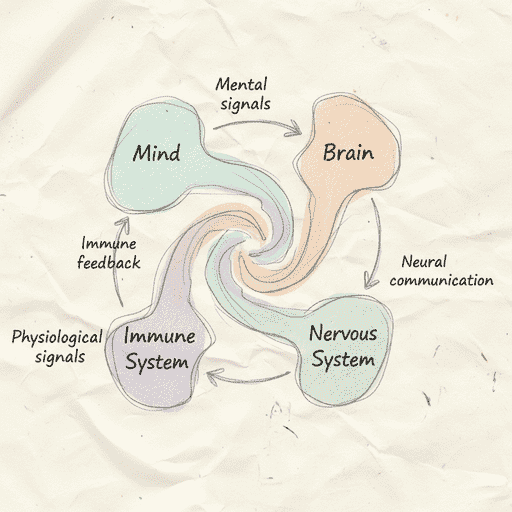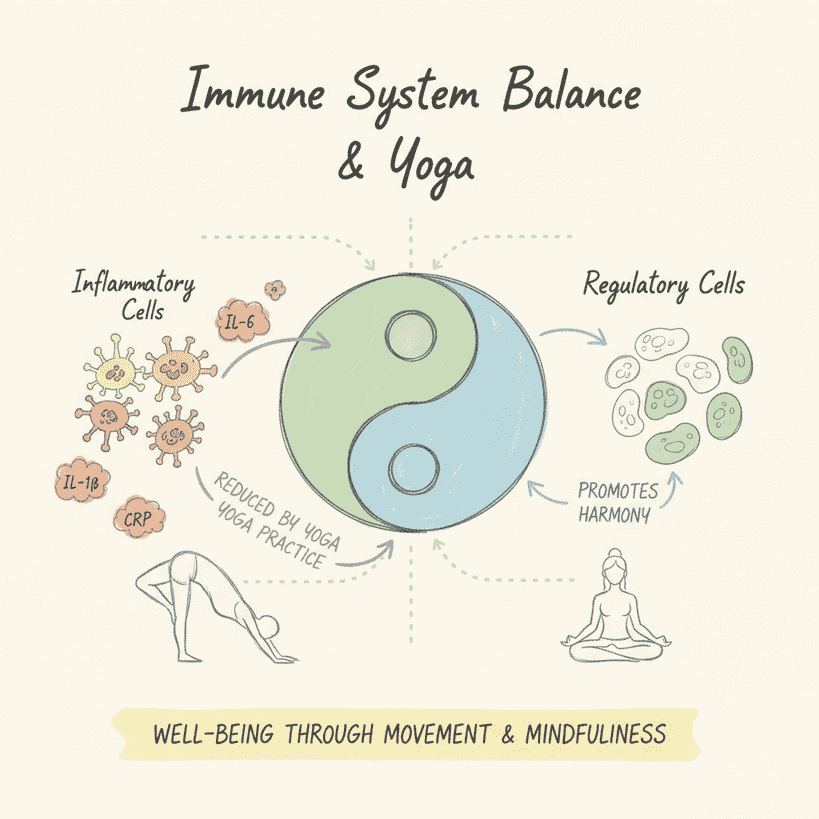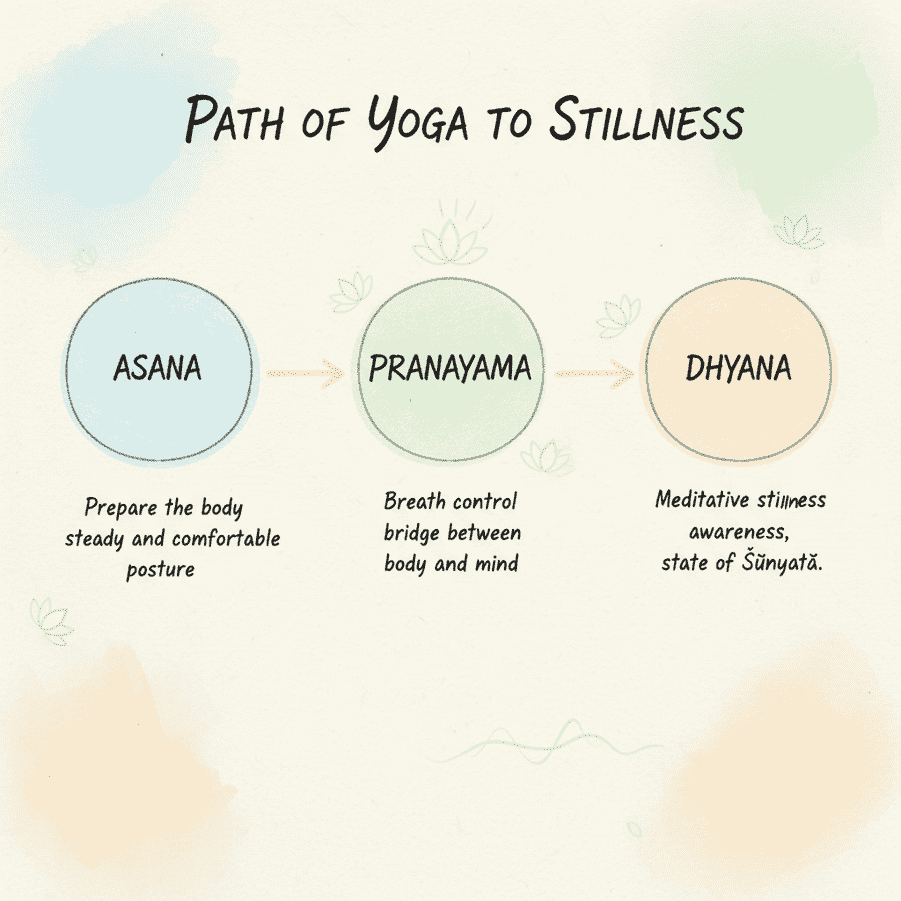As a doctor on the front lines of the COVID-19 pandemic, I witnessed the relentless battle between a virus and the human body. Working in the ICU, I was surrounded by the triumphs of modern medicine, yet I was also devastated by its limitations as I saw too many lives lost. In that intense environment, I came to understand that health is not simply about eradicating disease but about achieving a delicate balance—especially within the immune system.
This balance determines whether the body remains resilient or falls victim to illness. It was during this time that I discovered a research paper online—the foundation of this article—that illuminated the profound interplay between the mind and the body. The research highlighted the crucial role of a balanced immune system, showcasing the power of yoga healing body and mind from within. This pivotal realization opened my eyes to a more holistic model of healing.
This perspective aligns perfectly with the foundational principle of the World Health Organization (WHO), which defines health not as the mere absence of disease or infirmity, but as “a state of complete physical, mental and social well-being”. It’s a definition that calls for an approach that nurtures the whole person. And there is perhaps no practice that embodies this holistic vision more completely than yoga. This ancient discipline, originating in India, is now globally recognized as a vital tool for well-being, so much so that the United Nations, proclaimed June 21st as the International Day of Yoga in 2014, recognizing its universal appeal and benefits for world health.
This article explores the science behind how yoga works, weaving together ancient wisdom with modern research to show how this practice can help you tap into your body’s innate healing intelligence.
The Immune System: The Gatekeeper of Health
The immune system is the cornerstone of human health, acting as the body’s vigilant guardian against disease and imbalance. Its primary role is to discern between threats and harmless entities, mounting defense responses to protect us from infections, toxins, and even abnormal cells like cancer.
However, health is not simply the absence of pathogens; it is the dynamic equilibrium maintained by a balanced immune system. When this balance is disrupted—either through overreaction, as in autoimmune diseases, or underperformance, as in immunodeficiency—the body becomes vulnerable to a wide range of illnesses. Thus, the state of the immune system largely dictates whether we experience vitality or disease, making it the fundamental determinant of health.
The Mind-Body Superhighway: A Two-Way Conversation
For decades, the brain was considered an “immune-privileged site,” shielded from the body’s immune functions by the blood-brain barrier. The prevailing belief was that these two powerful systems operated in isolation. However, groundbreaking research in a field called Pschoneuroimmunology has shattered this old paradigm. We now know there is a constant, two-way dialogue between the brain and the immune system through nervous system. This dialogue between the brain and immune system is the scientific basis for the mind body connection that yoga has cultivated for millennia. The word Psychoneuroimmunology has 3 components- 1)Psyche– i.e your mind (or ‘Manas’ in Sanskrit), 2) Neuro– i.e your nervous system 3) Immunology or your Immune system

Think of it as a biological superhighway:
- Your Immune System Talks to Your Brain: When your immune system responds to an infection or injury, it releases signaling molecules called cytokines. These molecules are recognized by your nerves and the impulses travel to the brain and influence everything from your mood and energy levels to your cognitive function and emotional state.
- Your Brain Talks to Your Immune System: In turn, your brain sends signals that regulate your immune system’s activity. Your psychological state is not just a feeling; it’s a physiological reality. Chronic stress, anxiety, and even your personality type can directly alter your immune response, often leading to chronic inflammation, the smoldering fire behind many modern diseases.
Yoga and meditation are powerful because they provide a direct method for consciously intervening in this mind-body conversation. The central hypothesis, supported by a growing body of evidence, is that if the mind and body are so deeply linked, then working on one can directly heal the other.
Rewiring Your Brain for Health and Resilience
One of the most exciting discoveries in neuroscience is the link between yoga and neuroplasticity—the brain’s remarkable ability to reorganize itself by forming new neural connections throughout life. Your thoughts, habits, and experiences physically sculpt your brain. Yoga and meditation are potent forms of brain training that drive positive neuroplastic changes.
- Growing a Healthier Brain: Research has shown that regular yoga practice can increase gray matter density in the brain, particularly in areas associated with higher-order functions like memory, attention, and decision-making. More time spent practicing yoga is associated with larger brain volume in regions involved in bodily awareness, stress regulation, and self-referential thought.
- Calming the Brain’s Fear Center: The amygdala is the brain’s alarm system, responsible for processing fear and triggering the stress response. Functional MRI (fMRI) studies have revealed that yoga and mindfulness practices can lead to decreased amygdala activation in response to stressful stimuli. This suggests that with practice, you can train your brain to be less reactive and more composed in the face of challenges.
- Strengthening the Brain’s “CEO”: The prefrontal cortex (PFC) is the executive center of the brain, responsible for emotional regulation, impulse control, and rational decision-making. Yoga has been linked to heightened activity in the PFC, which contributes to better management of emotional responses and stress.
- Taming the Wandering Mind: The Default Mode Network (DMN) is a network of brain regions active during self-referential thought, or “mind-wandering.” An overactive DMN is often linked to anxiety and rumination. Mindfulness practices common in yoga have been shown to influence DMN activity, helping to reduce mind-wandering and shift away from worrying, thereby reducing psychological stress.
Through these mechanisms, yoga literally rewires your brain, building new pathways for calm, focus, and emotional balance while weakening the old pathways of stress and reactivity.
The Science of Yoga Stress Reduction: Taming the Fires of Inflammation
Chronic inflammation is a key driver of many major health conditions, including heart disease, diabetes, autoimmune disorders, and depression. Psychological stress is a primary culprit, keeping the body in a state of high alert and fueling this low-grade inflammatory fire. Yoga and meditation are powerful anti-inflammatory interventions.
A 2022 scientific review found strong evidence that yoga practices significantly reduce levels of key inflammatory markers circulating in the body. The mechanisms are multifaceted:
- Lowering Stress Hormones: Yoga has been shown to reduce levels of cortisol, the body’s primary stress hormone. When cortisol is chronically elevated, it disrupts normal immune function. By calming the stress response, yoga helps restore hormonal balance.
- Downregulating Pro-inflammatory Signals: Studies show that yoga can decrease levels of pro-inflammatory cytokines like Interleukin-1 beta (IL-1β) and Interleukin-6 (IL-6), as well as C-reactive protein (CRP), a protein that rises in response to inflammation.
- Altering Gene Expression: In a landmark study, researchers found that an intensive 8-day meditation retreat activated gene networks related to the immune system. A comprehensive review also showed that mind-body practices can reverse the expression of inflammatory genes, effectively turning down the “volume” on the inflammatory response at a molecular level. Another key finding is that meditation can reduce the activity of NF-κB, a crucial cellular transcription factor that acts as a master switch for the inflammatory process.

By targeting inflammation from multiple angles—from stress hormones down to the level of our DNA—yoga helps to extinguish the chronic, systemic inflammation that undermines health.
Strengthening Cellular Defenses: How Yoga Boosts Immunity
Beyond simply calming an overactive immune response, yoga and meditation can also enhance the immune system’s ability to protect the body from threats.
- Boosting Antiviral Responses: One of the most significant findings from research on advanced meditators is the robust activation of interferon (IFN) pathways. Interferons are proteins that play a critical role in the body’s frontline defense against viruses and other pathogens. The study noted that these same IFN pathways are often dysregulated in diseases like multiple sclerosis and severe COVID-19, suggesting that meditation could help restore a more effective immune defense.
- Enhancing Immune Cell Coordination: Research has also shown that mindfulness meditation can increase the number of CD4+ T helper cells, particularly in individuals with compromised immune systems like those with HIV. These cells are like the “generals” of the immune army, playing a crucial role in coordinating the overall immune response.
- Promoting Healthy Biological Aging: Telomerase is an enzyme that helps maintain the length of telomeres, the protective caps at the ends of our chromosomes that shorten with age. Shorter telomeres are associated with cellular aging and disease risk. Remarkably, studies have linked mindfulness meditation to increased telomerase activity, suggesting that these practices may help promote healthier aging at the cellular level.
These findings provide strong evidence for how the yoga immune system connection works to create a more resilient and balanced state of health.
The Psychological Pathways to Healing
While the biological mechanisms are compelling, the healing power of yoga also operates through profound psychological shifts. A clinical trial testing how yoga reduces stress identified several key psychosocial “active ingredients” :
- Increased Mindfulness: Yoga trains you to pay attention to the present moment without judgment, helping you break free from cycles of worry about the future or rumination about the past.
- Enhanced Interoceptive Awareness: This is the ability to sense the internal state of your body. Yoga cultivates a deep connection to your physical self, allowing you to notice subtle signals of stress or imbalance before they become major problems.
- Greater Self-Compassion: Kripalu yoga, the style used in the study, emphasizes a non-judgmental and accepting attitude toward one’s own experience. This self-compassionate stance is a powerful antidote to the self-criticism that often fuels stress and anxiety.
- Improved Spiritual Well-being: For many, yoga fosters a sense of connection to something larger than oneself, which can be a powerful resource for coping with life’s challenges.
By cultivating these internal resources, you become better equipped to navigate stress, regulate your emotions, and maintain a state of psychological well-being, which in turn supports a healthy body.
Yoga Healing Body: The Path to Stillness
To the modern eye, yoga might appear to be a collection of distinct practices: physical postures, breathing exercises, and seated meditation. However, in classical yogic science, these are not separate components but a sophisticated, sequential process designed to lead the practitioner towards a state of profound inner stillness.

- Asana (Postures): Preparing the Vessel
The physical practice of yoga asana is the foundation. Its primary purpose is not just to build strength and flexibility, but to prepare the body for the stillness required for deep meditation. The Yoga Sutras of Patanjali define asana as sthirasukham asanam—a posture that is both steady and comfortable. By working through physical tension and clearing energetic blockages, asana makes it possible to sit without the body becoming a distraction. A calm, stable body is the necessary vessel for a calm, stable mind. - Pranayama (Breath Control): The Bridge Between Body and Mind
Once the body is prepared, the focus turns to the breath. Pranayama is the conscious regulation of prana, or life force energy, through specific breathing techniques. The breath is the most tangible link between our physical body and our mental state; a stressed, agitated mind leads to shallow, rapid breathing, while a calm mind is reflected in a slow, deep breath. By consciously controlling the breath through pranayama, we can directly influence the autonomic nervous system, shifting it from a state of “fight-or-flight” to one of “rest-and-digest”. Pranayama is the crucial bridge that takes the stability created in the body through asana and translates it into tranquility for the mind. The pranayama benefits are profound, extending from calming the nervous system to directly influencing physiological markers of health. - Dhyana (Meditation): The Experience of Stillness
With a steady body and a calm, focused mind, the practitioner is finally prepared for Dhyana, or meditation. Asana and pranayama are the preparatory stages that systematically remove the physical and mental agitations that prevent us from experiencing our true nature. This ultimate state of stillness is a universal goal in contemplative traditions. In Buddhist philosophy, this is akin to the state of Śūnyatā (often translated as “emptiness” or “void”). This is not a state of nothingness, but rather a state of pure, wordless awareness—a “solid stillness” where the internal chatter of the mind has ceased, and one can simply be, without judgment or distraction. The journey of yoga, therefore, is a progression from outer movement to inner quiet, using the body and breath as tools to uncover the profound peace that already exists within.
A Path to Self-Healing
My experience in the ICU showed me the limits of a purely mechanical view of health. The science I’ve shared here confirms what ancient traditions have known for millennia: true wellness arises from harmony between mind, body, and spirit. It’s a vision of health championed by the WHO and celebrated every year on the International Day of Yoga.
Yoga offers an accessible, evidence-based path to achieving this holistic well-being. It is a journey of self-discovery that empowers you to become an active participant in your own health. By stepping onto the mat, you are not just stretching your muscles; you are tuning into the profound connection between your mind and body and unlocking your body’s innate capacity to heal itself.
Embrace this path with openness and patience, knowing each breath and movement brings you closer to lasting balance and vibrant health.
To deepen the transformative effects of yoga on both body and mind, incorporating regular meditation can be invaluable. Simple meditation practices complement yoga by cultivating focused awareness, reducing stress, and enhancing mental clarity, which together amplify overall healing and well-being. For those interested in exploring accessible meditation techniques that can seamlessly integrate with a yoga routine, the article on Simple Meditation Practices offers practical, beginner-friendly guidance to start or enrich a mindful healing journey.












